This summer I updated my database of T.A. Scott’s rescue and salvage work for the period between 1879 and 1902. After not thinking much about this data set for three years, I plunged back into historical newspaper databases (much expanded and improved in just a couple of years) and added more than 50 events to the database. I’m sure there are more Scott salvage jobs still hiding in obscure newspapers, but I’m feeling pretty confident I found the vast majority. All told, the database includes 247 separate rescue or salvage events. It’s not clear how many he personally supervised (contemporaries often seemed to conflate Scott the man with Scott the salvage company), but I think it safe to say he was personally involved in most. The database includes the month, year, type of vessel involved in the incident, the vessel’s name, the type of wreck (founding, stranding, ice, fire, damaged), and whether or not it was recovered or repaired. After cleaning up the database with OpenRefine, I used Excel and Tableau Public to create the initial visualizations below. I’m working up some fancier ways to display this data… look for those soon.
The first two graphs show the annual and seasonal variation in Scott’s salvage work. Marine salvage was anything but steady and the wide variation in salvage work belies just how important non-salvage activities must have been to the T.A. Scott Company. Winter and spring were his busiest salvage seasons. Summer activity was slower because there were fewer wrecks and because he focused resources on lucrative (and relatively steady) marine construction jobs. I want to plot Scott’s work against the number of reported incidents in eastern Long Island Sound to see if there is any correlation between number of wrecks/incidents and his salvage activity.
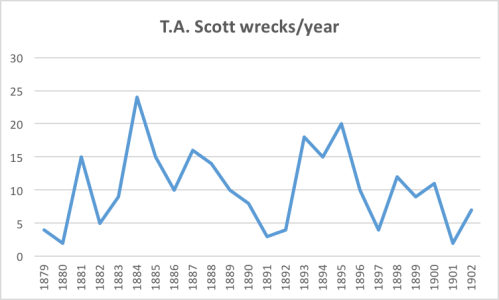
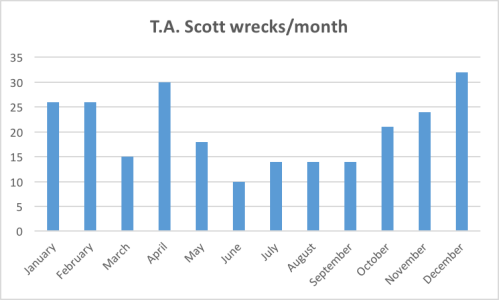
Other trends emerge as we dig into the data. Most notably, the bulk of Scott’s salvage work involved stranded schooners. Steamers and barges were tied for a distant second and an eclectic mix 13 other vessel types took up the remainder. Second, we have large gaps in the data — we do not know, for example, the “type” of wreck for 67 incidents. Possibly with further research we’ll be able to fill in these blanks. (to explore the graphs click here and here.)
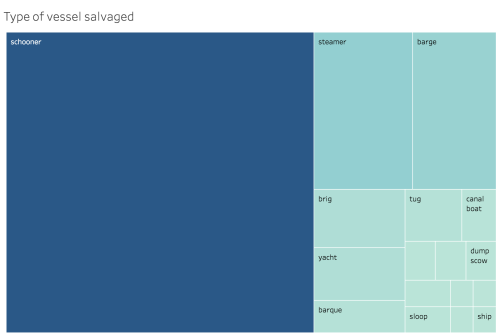
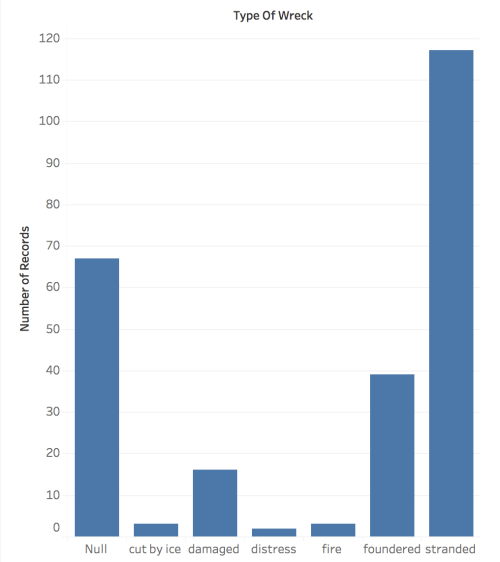
More to come soon…



 Defining “the coast” is notoriously difficult. I tend to favor a broad, inclusive definition and always seem to fall back on John Stilgoe’s concise articulation: “Between deep sea and ordinary inland landscape.” I loved his provocative exploration of the Massachusetts coast in Alongshore and how his definition captures both the fluidity of the coastal environment and the importance of subjective experience to understanding it. Look out for a future post where we tease out some of the implications of that definition. But suffice to say that “the coast” reaches far beyond that ever-shifting line where water meets land.
Defining “the coast” is notoriously difficult. I tend to favor a broad, inclusive definition and always seem to fall back on John Stilgoe’s concise articulation: “Between deep sea and ordinary inland landscape.” I loved his provocative exploration of the Massachusetts coast in Alongshore and how his definition captures both the fluidity of the coastal environment and the importance of subjective experience to understanding it. Look out for a future post where we tease out some of the implications of that definition. But suffice to say that “the coast” reaches far beyond that ever-shifting line where water meets land.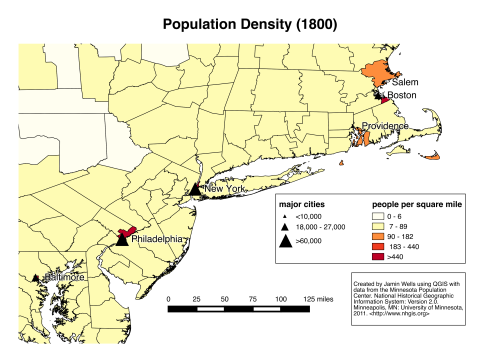 Ten years ago I took an introductory Geographic Information Systems (GIS) class. It was a bit mystifying (as those technical courses can be to us humanities folks) but I could see the potential. I’m sorry to say that the ins and outs of ArcGIS faded from memory as I ran that marathon of coursework, comps, prospectus, etc., etc. Yes, I actually reverted to paper maps, highlighters and, yes, dear reader, I used thumbtacks. It worked for what I needed then, but I need a bit more now.
Ten years ago I took an introductory Geographic Information Systems (GIS) class. It was a bit mystifying (as those technical courses can be to us humanities folks) but I could see the potential. I’m sorry to say that the ins and outs of ArcGIS faded from memory as I ran that marathon of coursework, comps, prospectus, etc., etc. Yes, I actually reverted to paper maps, highlighters and, yes, dear reader, I used thumbtacks. It worked for what I needed then, but I need a bit more now.